Menu
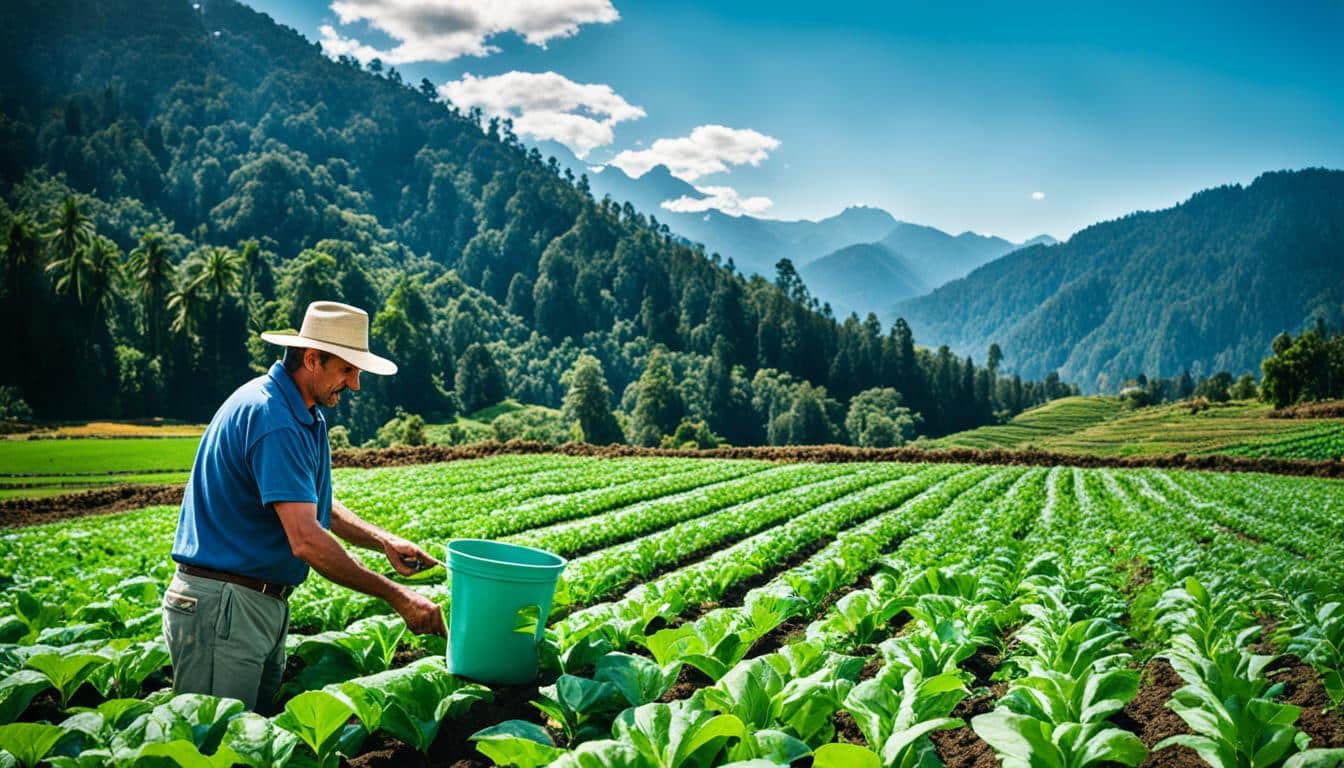
Did you know global farming productivity has dropped by 21% because of climate change? This fall equals about seven years of growth since the 1960s. It shows why we urgently need to change how we farm to fight climate change.
In 2018, the Conference on Climate Change and Food Security brought together experts and farmers. They talked about how climate change affects farming. Research papers and discussions showed why we must move towards sustainable farming. They also said policymakers must help by providing support and encouraging better farming practices.
New farming methods, like protected structures and aquaponics, are doing better than the old ways. They use less water and are stronger against climate change. Some methods, like using bio-charcoal, make the soil better for growing crops. Growing plants that can handle more water or less, like flood-tolerant rice, also helps a lot.
Climate-Smart Agriculture (CSA) is key for making farming sustainable, amid climate change. It helps increase productivity while protecting our planet. With agriculture causing a third of all emissions, we must lower this number with CSA’s help.
The world’s need for food is growing, with almost 10 billion people expected by 2050. This rises the demand on our food systems that already harm the environment through pollution and deforestation. These systems also use 70% of the planet’s fresh water.
Only 4% of the funds for fighting climate change go to agriculture, with just a fifth for small farmers. However, the World Bank is increasing its support for CSA significantly. Now, all World Bank projects must support the Paris Agreement’s goals, showing the growing importance of CSA.
Farmers benefit from using CSA, and partnerships between agencies and countries are key. This was discussed at a conference in The University of the West Indies, focusing on strategies like the Climate-Smart Agriculture Investment Plans. These plans are being used in countries like Bangladesh and Zambia, guiding them towards more sustainable farming.
Initiatives like the Food Systems Resilience Program in Africa and ARDI in Jordan show the world’s effort to make food systems more resilient. They aim to reduce the risk of food shortages and improve the agriculture sector’s strength and fairness.
Small farmers, especially in regions like South Asia and sub-Saharan Africa, are crucial for feeding the world. As the population grows, CSA becomes more important, also in dealing with water shortages. It promotes careful water use through methods like rainwater harvesting and smart irrigation.
CSA helps farmers fight pests and diseases by using smart farming methods. Tree planting and improving soil health not only boost yields but also fight climate change by absorbing carbon.
Providing the right knowledge and tools to farmers, especially in cocoa-growing areas, empowers them to farm in a way that’s good for the planet. Success stories, like in Malawi where maize harvests grew, show how impactful CSA can be.
In short, Climate-Smart Agriculture is a powerful, united way to farm sustainably. It safeguards our food future by making sure farming is good for the earth and productive.
The world is facing big challenges because of climate change. This makes using sustainable farming methods very important. The current food system creates about one-third of emissions. With the population expected to grow to 9.7 billion by 2050, supporting eco-friendly farming is urgent to protect our future. It’s critical to choose ways of farming that help our environment and fight climate change.
Sustainable farming benefits our planet and our societies in many ways. Let’s explore the main advantages of farming with the earth in mind:
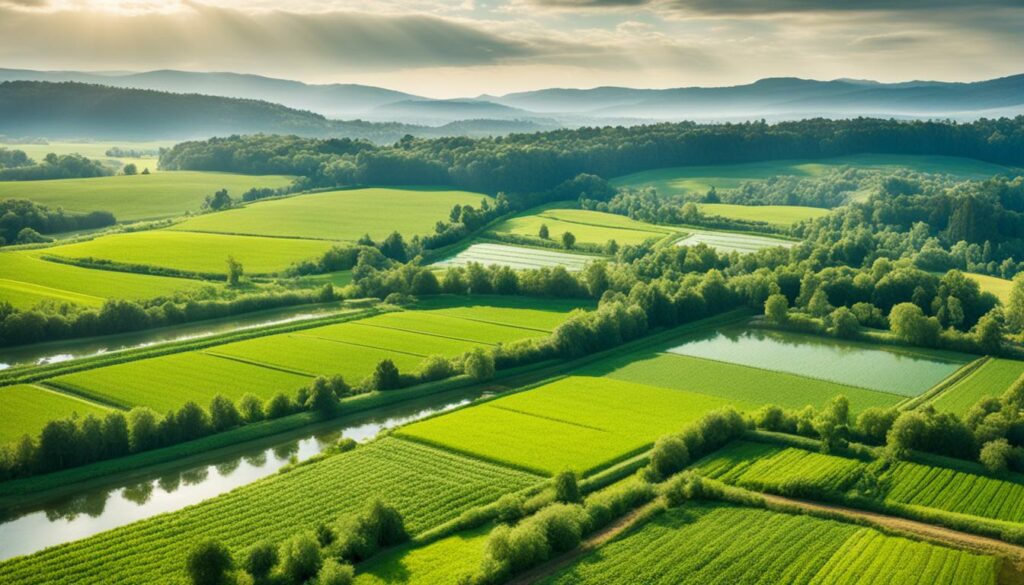
Lindsay Klaunig’s farm in Appalachia, Ohio is a great example. She uses special farming methods that fit the local weather. By terracing the land and rotating crops smartly, she not only gets better harvests but also uses water and protects the soil better.
Climate-Smart Agriculture (CSA) is now getting a big push from the World Bank, reaching almost $3 billion a year in funding. CSA projects make sure new farms meet the goals of the Paris Agreement. They focus on farming in ways that are good for the planet.
| Country | Funding Program | Amount (US$) |
|---|---|---|
| China | Green Agricultural and Rural Revitalisation | 345 million |
| Eastern and Southern Africa | Food Systems Resilience Program (Phase 3) | 621 million |
| Punjab, India | Resilient and Inclusive Agriculture Transformation (PRIAT) | 200 million |
| Jordan | ARDI program | 125 million |
With climate change getting worse, modern farming is key to being eco-friendly and sustainable. These new methods give more crops, use less water, and fight off bad weather.
Aquaponics and hydroponics are about farming without soil and very little water. In aquaponics, fish and plants help each other grow in a balanced system. This saves water, which is super important since most of the world’s water is used for farming.
Hydroponics grows plants in water with nutrients, skipping the soil. It’s great for saving water and can grow food in places with bad soil. Both ways of farming cut down on the environmental impact of making food.
Vertical farming is about growing food in the air, using less land space. It’s great for cities where land is limited. It also saves energy by growing food close to where it’s needed, which cuts down on transport pollution.
As the world’s population grows, so will the need for more food. Vertical farming can help meet this need without hurting our natural resources. It can make food all year long, no matter the weather outside.
| Technique | Benefits |
|---|---|
| Aquaponics | Combines fish farming with plant cultivation, maximises resource use, reduces fresh water demand |
| Hydroponics | Uses nutrient-rich water solutions, offers remarkable water efficiency, suitable for poor soil areas |
| Vertical Farming | Optimises urban space, reduces carbon footprint, ensures year-round production |
By 2050, Earth will have about 9.7 billion people. This makes climate-resilient agriculture very important. Today, food systems use a lot of fresh water and make much of the world’s methane. They also harm biodiversity.
Sustainable farming is key. It increases food and fights climate change. It’s important for our future.
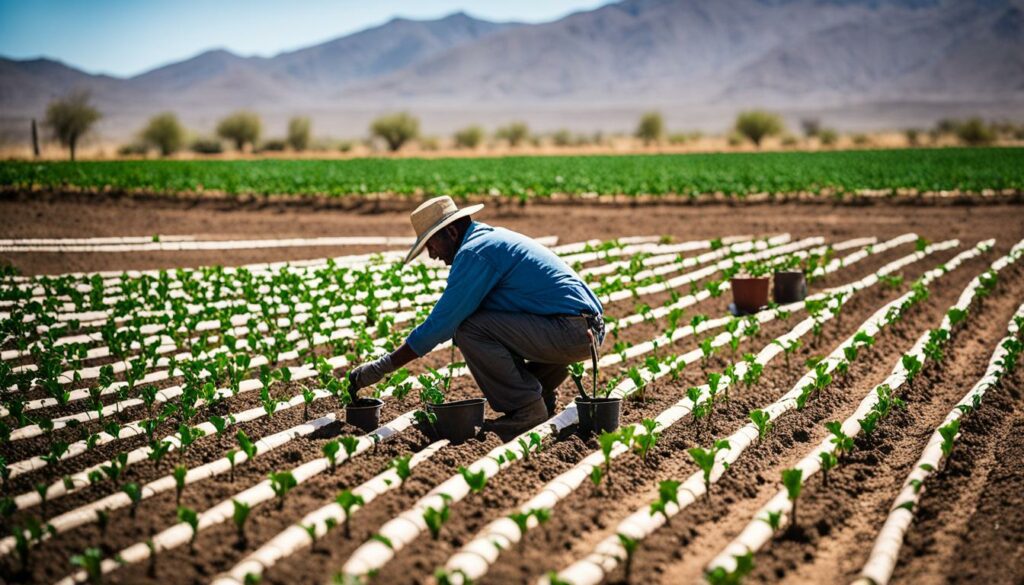
The World Bank now gives more for Climate-Smart Agriculture (CSA). They give nearly $3 billion a year. All projects must help the planet, starting July 2023. This effort is a big step for farming that is good for both people and the Earth.
One way to farm better is by growing drought-resistant crops. Agriculture often causes deforestation. But, by using less water, we can protect forests like the Amazon.
These crops can survive with little water. They keep producing, even in long dry spells. This helps us face the challenges of climate change.
Growing crops that can handle floods is also vital. Floods come more often due to climate change. About a third of emissions come from farming.
Flooding can destroy crops. But, planting flood-resistant crops helps. Projects in Africa and Punjab are working on this. They aim to make farming in these areas stronger against bad weather.
Finding ways to grow strong crops helps with food security. It also moves us towards more sustainable farming. This is our important goal.
Managing water well in farming is crucial today. It tackles the growing water shortage issue from climate change. Smart farming uses new ways to use water better, improve crop growth, and keep farms going strong.
Drip and trickle irrigation are key in smart farming. They send water straight to plant roots, using less water. Normally, farming uses a lot of water, but these methods cut that down. They lose less water to evaporation or runoff, helping farm water stay put.
Drip irrigation helps farming last longer, especially when water is scarce and weather is unpredictable.
Rainwater harvesting is a smart way to fight water lack and dry times. It collects rain for farm use, making a resourceful system. In places like sub-Saharan Africa, more farms can grow by using this method. This helps make more food and money. It’s crucial for saving water and offering a green choice under climate stress.
Mixing rainwater collection, hardy plants, and careful watering is a full-on smart farming plan. It needs both public and private groups working together. This boosts farm strength and growth.
Water use in farming is about more than just saving water. It’s also about using smart, green ways for a farming that lasts.
It’s vital to look after soil in farming for the long haul. By using smart soil-saving methods, farmers boost soil’s strength. They also help crops grow better. Mulching and bio-charcoal are two key methods showing how to farm sustainably.
Mulching is key for keeping soil healthy. It saves water, stops soil being washed away, and keeps the ground not too hot or cold. This method can add a lot of carbon to the soil, which is great for plants and covers the ground well. Using plants on top of the soil as a cover can even fix soils that are too packed and help add more natural stuff back to the earth.
Bio-charcoal is also really good for soil health. It’s full of carbon and makes the soil better for growing things. By putting products like bio-charcoal into the soil, we can make it harder for the soil to wash away. This trick also makes the soil better and a better place for helpful bugs and bacteria to live. Using bio-charcoal is all about making sure that our farms can be strong and healthy for a long time.
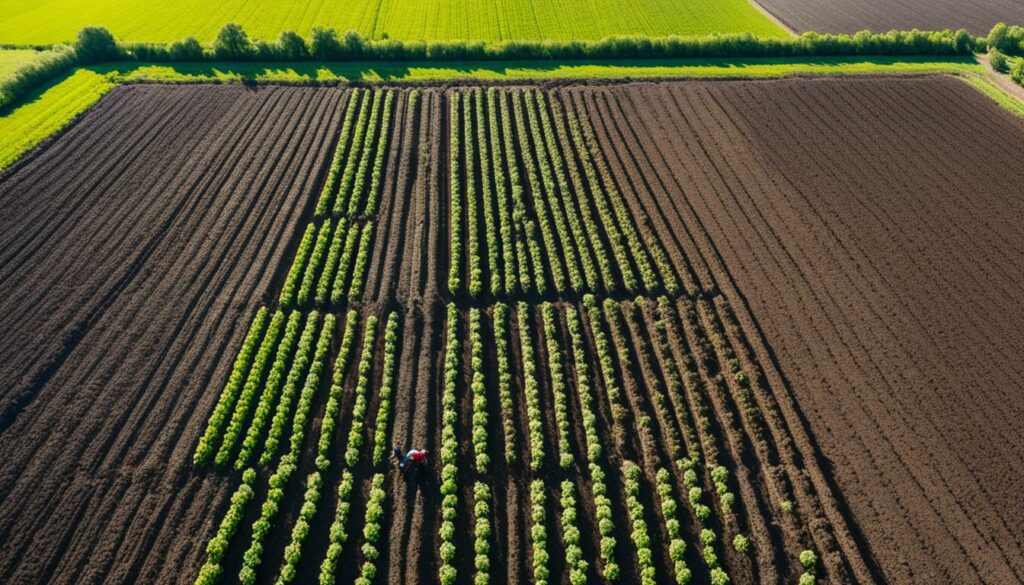
To sum up, mulching and bio-charcoal techniques are great for the land. They make soil healthy and they’re good for the planet. For more ways to care for soil well, check out what NRCS suggests. They’re all about smart farming to protect our soils and planet.
| Technique | Benefits |
|---|---|
| Mulching | Increases soil carbon sequestration, improves moisture management, limits erosion, enhances plant health |
| Bio-Charcoal | Enriches soil, increases productivity, curbs soil erosion, boosts soil organic matter |
In the face of a changing climate, adaptive crop breeding leads the charge. It creates crops that can survive harsh conditions better. These advanced crops tackle problems like drought, floods, pests, and diseases. As a result, we have a chance to fight back against the 21% drop in global farming caused by climate change. This loss equals seven years’ worth of farming progress since the 1960s.
Thanks to new technologies, like Computomics’ tools, adaptive crop breeding is changing. Now, we can quickly see which plant traits will work best in different climates. For example, ⨉SeedScore® tech helps plant breeders find the best plants for the future. This can cut down the time it takes to develop a new crop by 2-6 years.
Across the world, real changes are happening because of adaptive crop breeding. In Saskatchewan, Canada, most cropland uses conservation tillage. This has made the region a key part of Canada’s food production. Yet, climate change still takes its toll, cutting 30% off what European farmers expected to grow. This is why we need crops that can stand strong.
Looking at it another way, the rise in drip irrigation’s market size to $3.4 billion in 2020 tells us something big. Its growth, expected to be 10.8% each year up to 2028, proves we must find smart ways to farm in changing climates.
| Statistic | Impact |
|---|---|
| 21% lower global farming productivity due to climate change | Equivalent to losing seven years of productivity gains |
| 30% nullified growth in European crop yields | Highlights the need for adaptive breeding in climate-smart agriculture strategies |
| $3.4 billion global market for drip irrigation (2020) | Expected 10.8% growth rate, demonstrating increased demand for sustainable water management |
| 93% of Saskatchewan’s cropland under conservation tillage | Contributes significantly to Canada’s agricultural output |
It’s clear that investing in new genetic tools and smart farming is not just about technology. It’s a must if we hope to feed the planet despite climate change. By using adaptive crop breeding and eco-friendly farming, we can make sure we all have enough to eat in the future.
In the fight against climate change, agricultural policy is key. It helps farmers use climate-friendly methods. It also gives them the support they need.

Good agricultural policy offers climate-smart agriculture incentives. These can be things like technology help, organic farming funds, and ways to reduce disaster risks.
For example, the World Bank is boosting its investment in Climate-Smart Agriculture. It now funds nearly $3 billion worth of projects every year. Also, China’s Green Agricultural Programme got a $345 million loan. And Eastern and Southern Africa received $621 million for their Food Systems Resilience Programme. This shows how important it is to support farming in different ways.
Small farmers often struggle to get enough help. They face their own set of challenges. Making sure they get the support they need is crucial. This can help more farmers choose sustainable methods.
Investing in research is also crucial. It leads to better ways to deal with the climate. For instance, looking into plants that can survive droughts or floods is essential.
Groups like the Africa Climate-Smart Agriculture Alliance are doing great work. They work on practical farming methods that deal with tough climates. In Madagascar, the System of Rice Intensification is a great example. It helps farmers cope with shifting weather patterns.
“Over 60,000 smallholder farmers, with approximately half being women, were involved in the Kenyan Agricultural Carbon Project (2010-2017), funded by the World Bank and operated by Swedish NGOs.”
Supporting research is key. The World Business Council for Sustainable Development knows this well. It emphasizes climate-smart agriculture. It’s about working together, from small local groups to big international bodies.
| Programme | Focus Area | Funding |
|---|---|---|
| China Green Agricultural and Rural Revitalization Program | Green Agriculture | $345 million |
| Food Systems Resilience Program for Eastern and Southern Africa | Resilience Building | $621 million |
Combining agricultural policy with climate-smart agriculture incentives really works. It supports both farming financially and through new research. This is how we make farming resilient and eco-friendly.
Climate-Smart Agriculture (CSA) helps the environment and the economy. It shows great results in saving costs, boosting productivity, and making more money. These economic highlights are from using CSA methods.
CSA methods often save a lot of money. By using water and soil efficiently, farmers can lower their expenses. A good example is drip irrigation and rainwater harvesting. They help in saving water and cutting water costs.
Using mulching and bio-charcoal also means farmers need less chemical fertilisers. This saves them money and adds to the economic benefits of farming sustainably.
Applying climate-smart techniques boosts the number of crops and how sturdy farms are. In Pakistan, farmers who used such practices saw a 32% hike in cotton and a 44% rise in wheat compared to others. They also noted a 53% hike in maize in southern Malawi.
This doesn’t just mean more food. It also cuts greenhouse gases by over 62% in parts of Ghana. These gains show how climate-smart agriculture brings in more money.
| Region | Crop | Yield Increase |
|---|---|---|
| Pakistan | Cotton | 32% |
| Pakistan | Wheat | 44% |
| Southern Malawi | Maize | 53% |
The world’s food system causes a lot of harm, yet it’s essential. It makes up one-third of all pollution, uses most of our fresh water, and is top in methane and biodiversity loss. Switching to CSA can soften these damages and secure food for nearly 10 billion people by 2050.
CSA also makes sure small farmers are more food secure. Focused on only a fifth of climate funds, it’s vital work. The World Bank puts nearly $3 billion each year into this. It aims to help meet Paris Agreement goals. Actions in China and resilience in Africa show CSA’s power to lift farmers’ lives and boost the farming industry.
Getting communities involved in farming is key to tackling climate change. Teaching farmers about climate-smart practices helps a lot. It makes their farms more resilient and supports both them and the environment.
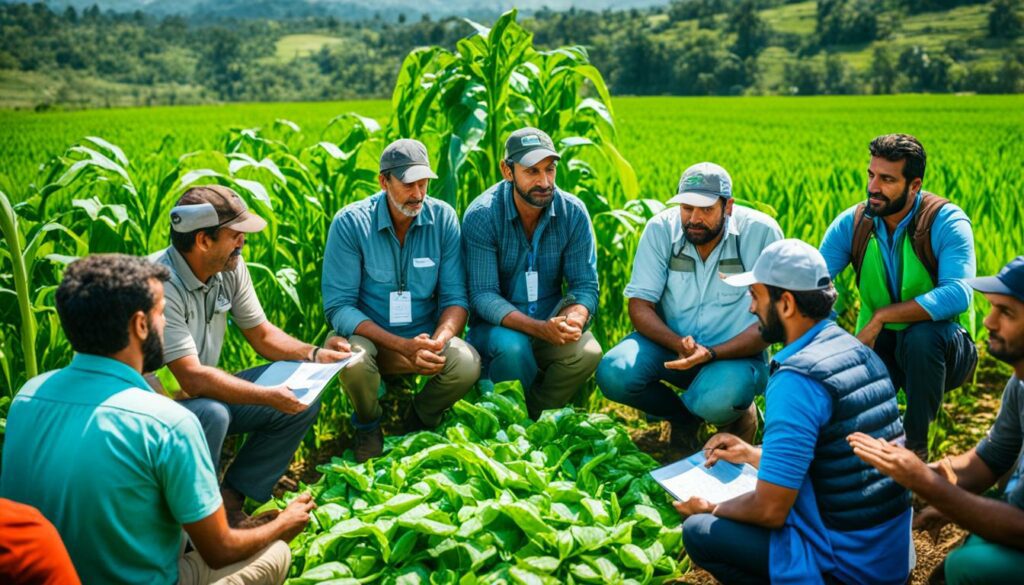
Teaching farmers is crucial. They learn about new seeds that can withstand droughts, better ways to manage soil, and saving water. They also learn how crop variety and planting trees can make their farms better for the planet.
It’s also very important to involve women in this training. They play a huge role in making these eco-friendly practices work long term. But, they often don’t have a big say in farm decisions. So, training needs to include women better.
Local projects help farmers come together and try new things. For example, there are schools where farmers learn from each other and groups where they save money. These projects want to make farms more successful but need more support to help everyone, especially women.
Working together in the community can also solve some big problems. In places like Tanzania, a focus on growing soybeans has worked well. But, it needs careful checking to make sure it’s really helping everyone.
| Community Approaches | Key Benefits | Challenges |
|---|---|---|
| Farmer Field and Business Schools | Higher crop yields, increased income | Requires continuous farmer engagement |
| Village Savings and Loan Associations | Empowers women | Minimal impact on household income and food security without support |
| Baseline and endline data collection | Enhanced adoption of CSA practices | Data accuracy and consistency challenges |
For these projects to last, they need ongoing help. This means making sure farmers can afford what they need and keep learning. Putting communities at the heart of farming helps build strong, lasting systems. This supports everyone who depends on farming.
Facing climate change, we need green farming methods for sustainable and eco-friendly crop making. Modern agriculture often aims for high productivity, forgetting to protect nature. Green farming uses practices that help the environment and increase crop yields.
Organic farming lies at the core of green farming. It ditches synthetic pesticides and fertilisers to boost soil health and biodiversity. The method uses natural compost, mulching, and rotating crops to make soil better. This leads to better crop growth and productivity.
Going organic helps the environment a lot. It stops soil and water pollution, helps useful insects, and keeps ecosystems balanced. With the world expected to have 9.7 billion people by 2050, using green farming to improve soil health is key to growing enough food.
Integrated Pest Management (IPM) is another key green farming part. It looks to prevent pests and their harm in the long run. It does this by using techniques like biological control and crop rotation. By lowering reliance on chemical pesticides, there are fewer environmental and health risks.
IPM checks pest numbers, uses crops that pests don’t like, and brings in predator insects to keep pests in check. It also includes using insect traps and regular weeding. These methods are crucial for balanced ecosystems and high farm output.
In short, applying green farming methods such as organic farming and IPM is crucial. They lower chemical use, boost biodiversity, and help farming and nature work well together. This way, we can have sustainable crop making.
Reducing the environmental impact of farming is crucial since it makes up a third of all emissions. With food demand growing to feed a world of 9.7 billion by 2050, sustainable practices are key. Carbon-neutral agriculture leads these efforts, aiming to reduce our carbon use through better practices and by using more renewable energy.
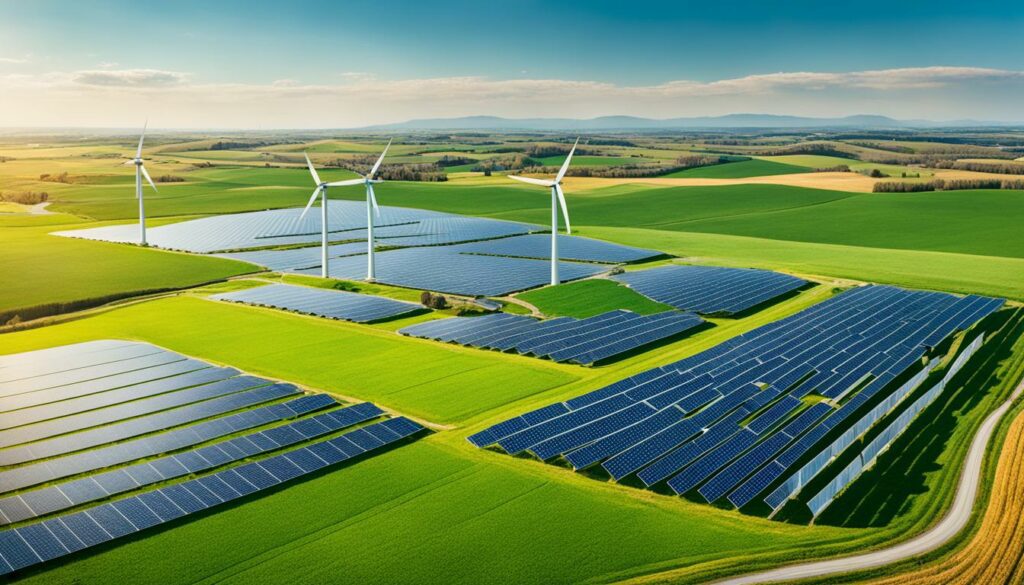
To achieve carbon-neutral farming, we must focus on storing carbon. Agroforestry merges trees with farmlands, and this is very effective. Additionally, many farmers are now using conservation tillage, which is good at trapping carbon. Cover crops also help, with over 10 million acres being used to sequester around 0.13 tons of carbon each year, which helps to lower CO2 in the air.
Switching to sustainable energy is vital for carbon-neutral farming. Farmers have cut methane emissions significantly by better managing water in rice fields. By using no-till methods, they’re using less diesel, saving fuel every time they avoid a tractor trip. Also, using solar and wind power in farming not only reduces emissions but also makes farms more independent and sustainable in the long run.
There’s a big global effort to back up green energy in farming. For example, the World Bank is increasing support for Climate-Smart Agriculture. And large projects, like the one in Eastern and Southern Africa with US$621 million, aim to make our food systems better prepared. These initiatives show a strong commitment to making agriculture carbon-neutral, a key step in fighting climate change while ensuring we can still feed everyone.
| Project | Region | Objective | Funding (USD) |
|---|---|---|---|
| China Green Agricultural and Rural Revitalization Program | China | Develop climate-smart technologies | 345 million |
| Food Systems Resilience Project | Eastern and Southern Africa | Enhance food systems resilience | 621 million |
| Punjab Resilient and Inclusive Agriculture Transformation Project | Pakistan | Support resilient agriculture | 200 million |
| Agriculture Resilience, Value Chain Development and Innovation (ARDI) | Jordan | Strengthen agri-food sector | 125 million |
We aim to ensure there’s enough food worldwide and that it’s nutritious. Climate change and a growing population are big challenges. To tackle these, we use smart farming methods. These methods help make crops more nutritious and available all year. This way, we meet the food needs of more people healthily.
With the world’s food needs set to rise, we’re working on making our crops more nutritious. We want to ensure that by 2050, when there will be 9.7 billion of us, people get the nutrients they need. This means focusing on foods rich in vitamins and minerals.
Crop breeding is key here. It’s about creating plant varieties full of vital nutrients. The World Bank is stepping up, with about $3 billion every year going into climate-friendly farming. This shows how important it is to strengthen these efforts.
It’s vital to keep growing crops all year, despite harsh weather. Things like managing crop leftovers, switching crops, and using better plant types help. They ensure farming stays productive whatever the season.
Investments, such as the US$621 million in Africa’s Food Systems Resilience Program, support this. Plus, smart water use, like drip systems and saving rainwater, is crucial. It keeps the farms going and helps fight the bad effects of too much or too little rain.
Emphasising sustainable and nutritious farming will make our food supply dependable. This approach lessens the harm climate change does to food. It also helps keep people around the world healthier.
Climate-smart agriculture needs countries to work together and share what works. Many global groups, like the World Bank and USDA, help make this happen. They aim to make farming stronger against climate change worldwide.
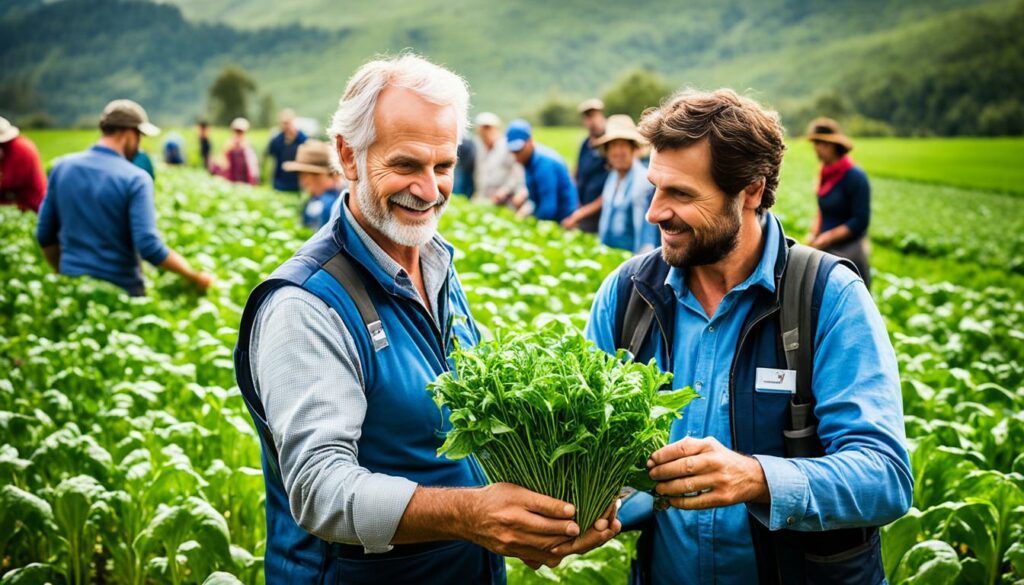
When countries come together, they can do more in farming. In Jordan, there’s the ARDI programme, and in Pakistan, PRIAT is making a big difference. These groups learn from each other to improve how they farm, with help from the USDA too.
Platforms to share farming knowledge are crucial. They make sure everyone can use the best farming ideas, including small farmers. The World Bank and others provide detailed help, focusing on each country’s needs. Programs like the Food Systems Resilience Program also help make farms stronger everywhere.
Key numbers remind us why this is important:
| Statistic | Details |
|---|---|
| Global Agrifood System Emissions | One-third of all emissions |
| World Bank Financing for CSA | Increased by eight times to nearly $3 billion annually |
| Fresh Water Usage by Food Systems | 70% |
| Agriculture’s Share of Climate Finance | 4%, with only a fifth going to smallholders |
In the face of changing climates, many areas and farmers around the world are finding new ways for farming. They aim to keep their lands productive and strong despite climate challenges. These agriculture success stories prove that with the right approach, farming can thrive even with changing conditions.
East Africa shines as an example of climate-smart agriculture. Look at the Mount Kilimanjaro agroforestry project in Tanzania. It changed 120,000 hectares of land, making local farmers 25% more in profit with coffee crops. This project involved 660 families and showed that you can benefit people and nature at the same time.
In Qinghai, China, a project worked to capture 63,000 tons of CO2 each year. It improved 38% of the damaged grazing lands. This effort is not only restoring land but also helping to reduce carbon in the air.
In the story of farming, individual efforts play a vital role. Farmers are using smart methods to better their farms and lives. Through groups like the Climate-Smart Agriculture Booster, many in Europe benefit, from the Netherlands to Italy, with over 25 new technologies.
These stories highlight the power of combining agriculture and climate care. The CSA Booster aimed to lock away 10 million metric tonnes of CO2 a year by 2020. It shows that farmers can make a big difference for the earth while improving their own lives.
| Region/Project | Area Covered | Impact |
|---|---|---|
| Mount Kilimanjaro Agroforestry | 120,000 hectares | 25% income increase for 660 households |
| Qinghai Grazing Initiative | 38% degraded land rehabilitated | 63,000 tons of CO2 sequestered annually |
| CSA Booster (Europe) | 5 regions | 10 million metric tonnes of CO2 sequestration target |
As we face a changing climate, we must focus on smart farming. This method is vital for all, especially in places like Africa and Asia. In these areas, farming struggles due to climate changes. Smart farming helps create a better future by balancing profit, caring for the earth, and helping communities.
Farming needs to change to meet the needs of growing populations. Smart farming is leading this change. It improves how we produce food, making it more secure and supporting local farmers. With the climate changing, we need new ways to grow food. This is where smart farming shines, by adapting and innovating to survive and thrive.
To make smart farming work, everyone must pitch in. From farmers to governments, we all have a role. By using new tech, fair markets, and good management, we can lessen the impact of climate change. Giving farmers tools to understand the climate better is also key. In the end, smart farming isn’t just a choice, it’s the way forward. It helps us protect our food and build a better future in farming.
Climate-smart agriculture (CSA) aims to make farming both profitable and better for the planet. It includes ways to grow more food, fight off climate change, and cut down on harmful greenhouse gases. CSA uses methods like careful farming, smarter water use, and growing plants that can handle different weather. These approaches help make farming more resilient and eco-friendly.
Sustainable farming is vital for the future of our food. It keeps the land healthy for the long run and protects our natural resources. By using sustainable methods, like looking after the soil, saving water, and supporting plant and animal variety, we can fight climate change. These methods are key in ensuring we have enough food for everyone and preserving our planet.
Modern farming techniques include aquaponics, hydroponics, and vertical farming. These are all about controlled environments to grow food more efficiently. They help save water and cut down the usual pollution from farming. This makes farming better for the environment and more sustainable in the long term.
Climate-resilient practices are all about planting the right crops that can survive harsh weather. For example, some plants can make it through droughts or floods. This stops the bad effects of climate change on our farms and makes sure we have enough food.
Better water use, like drip irrigation, saves a lot of water on farms. It also helps crops grow better and fights off the problems of too little water. This makes farming more sustainable, even when water is scarce or during droughts.
Soil conservation is key for keeping the ground fertile and fighting erosion. Methods like mulching and using bio-charcoal make the soil healthier. This boosts crop growth and keeps the land usable for the future, helping in the long-term sustainability of farming.
Adaptive breeding creates plants that are tough against droughts, pests, and more. By getting these special plants, farmers can keep on growing food during tough times. This makes farming more sustainable and able to handle various climate issues.
Policies on climate-smart agriculture help farmers do the right thing by giving them a push. They encourage using the best technologies and methods. Policies also support making the farms safer from disasters. All this is essential in spreading good agricultural practices.
By using smart farming, farmers can save money, grow more food, and earn more. It makes their farms stronger against bad weather and other challenges. This means they can do better financially while helping the environment.
Getting everyone in farming communities to learn about smart agriculture is crucial. Training helps them use new, sustainable ways to farm. Together, they can make farms safer, more resilient, and better for producing food. Community projects also play a big role in spreading these useful techniques.
Green farming is all about farming without harming the environment. Things like organic farming and watching out for pests in a natural way are part of it. These techniques protect wildlife and keep the farm land healthy for many uses. They ensure we can grow food in a way that doesn’t hurt the planet.
Carbon-neutral farming is all about farming that doesn’t add more climate-changing gases to the environment. This is done by planting more trees or using clean energy on farms. It helps in the fight against climate change and keeps farming sustainable.
Making sure there is always enough healthy food to eat means using clever farming methods. Climate-smart farming focuses on growing food that has the most nutrients. This way, we can eat well all the time, even when the weather is bad.
Working together with other countries helps everyone learn and share better farming ways. This way, farmers and policymakers worldwide can deal with the challenges of climate change in a more effective way. Global cooperation is essential in advancing sustainable agriculture.
Successful stories of climate-smart agriculture include both big projects and single farmers. They show how farming can be good for the earth and make money too. These stories inspire others and show that we can all have a positive impact on our environment and communities.